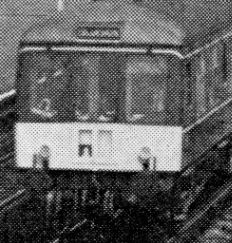Class 108 Derby 2,3 & 4-car DMUs
Liveries
Green with no whiskers

All vehicles were delivered in green and probably all the 50xxx vehicles appeared in 'Multiple Unit' (the lighter shade), the 51/52xxx vehicles were probably in the darker 'Loco' green. All had with cream lining. Roofs were grey with white cab domes, buffer beams were painted red and the blue square coupling code was displayed above each buffer. Initail deliveries did not have whiskers, and such a set is seen at Whitby station on July 21st, 1958. Less than a month old, E50605 (presumably with 56196) is at the front of the 5.40pm Whitby - Middlesborough service, formed of a two-car 108 and two-car 101. They are awaiting the arrival of the 4.25pm ex-Scarborough before they depart as a combined train. Michael Mensing.

Green with whiskers
Most sets were delivered with 'speed' whiskers applied to the driving cab fronts below the windscreens. Such a set is this twim led by M56258 (presumably with M50975) working an ECS coming off the Aston line at Stechford in September 1959. Michael Mensing.
Green with yellow panel

During the early 1960s the speed whiskers gave way to the more visible yellow warning panels beneath the cab windows and the white cab roofs gradually changed to black, as did the roofs themselves. The image shows a Class 108 / 101 hybrid set departing from Billingham station with a Newcastle to Middlesborough (via Sunderland) service in 1966. Steve Davies Collection.

An image appeared on p247 of the October 1962 issue of Modern Railways showing a set in green with a much larger than usual yellow panel. It is working a Bletchley to Brighton excursion, and so presumed to be a Bletchley vehicle. The size of panel would reappear on the early blue repaints done at Doncaster.

Rail Blue with yellow panel
The all-over corporate image Rail Blue began to appear in 1966. There were varying amounts of yellow applied. Some sets had just a small yellow panel, with red buffer beams, and BR logos on the cab doors. Most early blue repaints had 3" numbers (4" became the norm in blue as it was in green). Here one of the first Chester sets to be painted blue approaches Port Sunlight in 1966. David Faircloth.
Sets treated at Doncaster had a larger sized yellow panel, as on this example on flickr.
Rail Blue with yellow cab doors
Some power cars had full yellow ends with the yellow wrapped around to include the cab doors. An example can be seen on flickr circa 1970 as part of a four-car 101 / 108 hybrid set.

Rail Blue with full yellow ends
Soon the yellow was standardised as just being the full cab front with black buffer beam. A Rail Blue set is seen at Morecambe in September 1970; DMBS E50613 is nearest the camera. Graeme Phillips Collection.
In 1971 a Newcastle set was noted carrying orange Tynerail stickers on the cab front.
Refurbished

The Class 108s were included in the refurbishment programme, and starting in 1975 some appeared in the livery of white with broad blue bodyside stripe which ran from end to end below the passenger windows. The cab fronts remained yellow, and the train describing panels had by this time fallen out of use and were either removed or plated over.
Modifications were made to the interior of the cars during refurbishment - carriage heating, floor and wall coverings, seating material and saloon lighting in most cases were replaced, improving passenger comfort and extending vehicle life. The livery however was superseded by the more conventional and durable Rail Blue and Grey scheme used on loco hauled stock.
The West Yorkshire PTE was quick to fund some refurbishments, the earliest included 108 twins from the 50599 batch, including 50601 (16/5/75), 50612 (6/6/75), 50613 (23/5/75), 50614(17/4/75), 50616 (29/4/75) all with matching DTCLs. The image shows E50614 + E56209 at Leeds on 13/06/1975. Note the miniature headcode display, as this was prior to their abolition in 1976. Graeme Phillips Collection.
First Class stripes
Later most if not all first class accommodation on DMC and DTC was downgraded to second class, losing the yellow stripes, the vehicles involved becoming DMS and DTS respectively. The exceptions were a handful of 108 DTCLs were refurbished at Tyseley in 1987 for use with newly-gangwayed Class 115 MBS on Marylebone services and these had First Class reinstated. Initially they carried the existing Blue/Grey livery, embellished with First Class markings, but then NSE livery was applied.

Blue / Grey
A couple of blue / grey sets are seen at Mochdre, before the building of the now adjacent A55 expressway, on the 28th August 1981. Bill Read.

White Roof Domes
In 1985 Buxton depot applied white to the roof domes of some of its Class 108s, something of a tradition at this depot having earlier treated its Class 104s similarly. Also with black around the cab windows, the image shows set BX490 waiting for departure time in Platform 2 of Buxton station on 18th June 1985. Paul James. On closure of Buxton depot its vehicles became dispersed but in general the white cab roofs remained on its vehicles and could be seen during the late 1980s at depots such as Chester, Tyseley and Swansea (Landore).

Retro Green
One set, 53964 and 54247, was later painted back into green. Initially it had just the lower cab painted yellow, later the full cab front was treated. Malcolm Clements.
Network South East
A few sets appeared in NSE livery. The image shows such a set (54194 + 51916) having just arrived from Corby, on 2nd June 1990. This was the last day of regular passenger services over the Kettering-Corby route until February 2009. Andrew J Crowther.
Summary
Orders
Description
Works Photographs
Modifications
Refurbishment
Diagrams
Numbering & Driving Inst.
Liveries
Operations
- Scotland
Accidents
Decline
Non-Passenger Use
Images
Details about preserved Class 108s can be found here.



